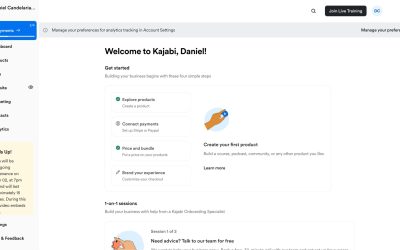Private Practice Prep for Grad Students–from live interview with Lily Dawson
Hey grad students!
Are you wondering how to get a head start on entering into private practice after school?
Well, we just had a live interview with Lily Dawson, a provisionally licensed therapist who has done an amazing job transitioning from grad school to private practice (making six figures in just 3 months!) and we wanted to share some of the biggest takeaways from the conversation.
Now, this transition didn’t come easy for Lily and she talks about how she had to do a lot of work after she graduated in order to get to where she is now.
We asked her what she wished she would’ve known in grad school to better prepare for getting clients and building a sustainable practice, and here are some of the main points of what she said (with some we added ourselves!).
1. Create a website
Your website is your “hub” where you can direct any and all referrals, potential clients, and marketing to. This is where people can learn about you and get to know your style and who you are as a therapist, but most importantly they’ll be able to discover how you’re going to help them.
A website takes time and money to build, but we suggest you do this even before you graduate.
Why?
Because with a website your business becomes real. People respect and trust businesses with a web presence where they can learn everything they need to know about what you offer and how to sign up for it.
If you haven’t taken a look at Storybrand (the book, podcast, or even just the website) we highly recommend doing so. This will give you a better idea of how to create and structure your website.
The Storybrand brandscript will guide you through how to create copy and structure for your website so potential clients will become engaged with your message, and will understand just how you specifically can help them with their unique needs.
If you’re intimidated by a website, don’t be! Squarespace is a great option for website creation, and hiring a developer/and designer is worth investing in if you want a thriving private practice.
Tip: Skip hiring a designer/developer with customized Squarespace templates! Get 10% off custom Squarespace templates here using the code PRIVATEPRACTICE10
2. Know how you’re different
Take a few months while still in school and begin thinking about your style of therapy, who you like to help, and most importantly, how you’re unique from your classmates or other therapists in your area.
What is it you can offer that others can’t? This is what is going to set you apart from other therapists even if they offer similar services.
Even if you don’t totally know what you want to specialize in, or if it will change over time, use what you know and begin brainstorming how your type of therapy, approach, and personality are different from others.
Use what you come up with on your website to give potential clients a good idea if they will connect with you (remember you do NOT need to be relatable to everyone, stay focused on what makes you unique!)
3. Brand yourself well
Make sure you think about and pick your font, colors, logo, and overall theme of your practice.
Even if you’re going to join a group private practice after school, you’re still your own business and branding is what gives you an identity.
For people to attach and identify with your practice, you need to stay consistent with colors, fonts, your logo, and your content.
These are how you express who you are and what clients can expect when coming into a session with you (this is especially important for a therapist as starting therapy is scary for many of us and knowing what you’re getting into is a game-changer!).
So go ahead and choose your colors (down to the color code #), one or two fonts you like, have someone create or create your own logo, and start thinking about what kind of content you want to put out there that aligns with your brand.
Hint: You can figure out most of these by going to canva and playing around until you find what fits best.
Remember to be consistent across all platforms with these: your website, social media, and any other sort of content you create!
4. Engage
Although therapists on Instagram is a fairly new concept, it’s bigger than ever and a great way to market yourself AND build your network with other therapists.
Don’t just create content and post it, actively engage and get to know others on the platform. Like and respond to their posts and stories, interact with stickers and questions on their content, send a DM to a therapist you respect and let them know you love their content!
If you want to grow a supportive community online, it’s more than possible, but you have to be authentic and consistent. Over time, you’ll get to know other mental health professionals and discover ways you can help one another.
Social media is also a great way to build an audience and direct them back to your website, and get them to sign up for your email list.
5. Build your audience with an email list..the earlier the better!
This is the number one thing to focus on while still in school!
If you can get people to subscribe to your email list it’s almost guaranteed you’ll have clients waiting for you before you even graduate.
Your email list subscribers are already interested in what you have to offer, so it’s more than likely they could become therapy clients one day.
Having a weekly newsletter where you give free tips is a great way to keep subscribers engaged and updated.
You can also use your list to keep track of who is interested in what topics and cater their emails to hit on exactly what they want to know more about.
Tip: We suggest using Converkit for your email list!
We’ve actually even created an email funnel for you, so you don’t have to spend hours trying to figure it out yourself! Steal our FREE email funnel now!
Get the Funnel6. Create content
Once you have your website up and people can subscribe to your email list, you may be wondering… how can I get people to subscribe?
The answer is–Lead Magnets!
Lead magnets are basically something free you offer but in order to receive your free content, the subscriber has to give you their email in exchange.
This could look something like a free anxiety guide, a list of books you recommend for depression, or a video meditation.
Get creative and make sure whatever you offer is something your audience would be interested in.
Check out our blog post for tips on how to create content that converts here.
Once you’ve created it, connect it to your email list sequence and watch new subscribers roll in!
To watch the live interview with Lily, click below!
or listen on our podcast:
-PPW



